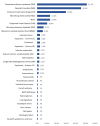Characteristics and Associated Risk Factors of Neonatal Sepsis: A Retrospective Study From Saudi Arabia
- PMID: 39872571
- PMCID: PMC11771527
- DOI: 10.7759/cureus.76517
Characteristics and Associated Risk Factors of Neonatal Sepsis: A Retrospective Study From Saudi Arabia
Abstract
Introduction Neonatal sepsis is defined as a systemic illness caused by bacteria, viruses, or fungi, characterized by hemodynamic abnormalities and clinical findings that result in morbidity and mortality. Neonatal morbidity and mortality are significantly influenced by neonatal sepsis. Causative pathogens and antimicrobial sensitivity profiles have changed over time, with significant geographic variation. Aim To determine the characteristics and associated risk factors of sepsis among neonates admitted into neonatal intensive care units (NICU) in Maternity and Children Hospital, AlAhsa, Saudi Arabia. Methodology An institution-based retrospective cross-sectional study was conducted among neonates who were admitted to the neonatal intensive care unit from January 2022 to December 2023 at the Maternity and Children Hospital, AlAhsa, Saudi Arabia. All neonates born with clinically diagnosed sepsis and positive culture were included in this study. Results This study included 134 neonates with a culture-proven diagnosis of neonatal sepsis during the study period. There were 23 (17.2%) cases of early-onset sepsis (EOS) and 111 (82.8%) cases of late-onset sepsis (LOS). Compared to late-onset sepsis (18.8%), Pseudomonas aeruginosa is more common in early-onset sepsis (33.3%). In cases of early-onset sepsis, Escherichia coli is isolated more often (33.3%) than in cases of late-onset (9.4%). Neonatal sepsis mortality is higher in LOS (25 [22.5%]) than in EOS (3 [13%]). Neonates with extremely preterm birth weight, gram-negative sepsis, and thrombocytopenia have a significantly higher mortality rate (p=<0.05). Conclusion In order to lower the risk among newborns, policymakers and/or managers will benefit from the information provided by the assessment of the prevalence, clinical outcomes, and risk factors for neonatal sepsis. Furthermore, developing hospital-based care strategies requires an understanding of the microorganisms that cause infections among neonates.
Keywords: alahsa; antibiotic resistance; antibiotic sensitivity; neonatal intensive care unit; neonatal sepsis; prevalence; risk factors; saudi arabia; septicemia.
Copyright © 2024, Al Ghadeer et al.
Conflict of interest statement
Human subjects: All authors have confirmed that this study did not involve human participants or tissue. Animal subjects: All authors have confirmed that this study did not involve animal subjects or tissue. Conflicts of interest: In compliance with the ICMJE uniform disclosure form, all authors declare the following: Payment/services info: All authors have declared that no financial support was received from any organization for the submitted work. Financial relationships: All authors have declared that they have no financial relationships at present or within the previous three years with any organizations that might have an interest in the submitted work. Other relationships: All authors have declared that there are no other relationships or activities that could appear to have influenced the submitted work.
Figures







Similar articles
-
Characteristics of neonatal Sepsis at a tertiary care hospital in Saudi Arabia.J Infect Public Health. 2019 Sep-Oct;12(5):666-672. doi: 10.1016/j.jiph.2019.03.007. Epub 2019 Apr 13. J Infect Public Health. 2019. PMID: 30992228
-
Pathogens distribution and antimicrobial resistance in bloodstream infections in twenty-five neonatal intensive care units in China, 2017-2019.Antimicrob Resist Infect Control. 2021 Aug 16;10(1):121. doi: 10.1186/s13756-021-00989-6. Antimicrob Resist Infect Control. 2021. PMID: 34399840 Free PMC article.
-
Neonatal sepsis: a 6-year analysis in a neonatal care unit in Taiwan.Pediatr Neonatol. 2009 Jun;50(3):88-95. doi: 10.1016/S1875-9572(09)60042-5. Pediatr Neonatol. 2009. PMID: 19579754
-
Management of neonates at risk of early onset sepsis: a probability-based approach and recent literature appraisal : Update of the Swiss national guideline of the Swiss Society of Neonatology and the Pediatric Infectious Disease Group Switzerland.Eur J Pediatr. 2024 Dec;183(12):5517-5529. doi: 10.1007/s00431-024-05811-0. Epub 2024 Oct 17. Eur J Pediatr. 2024. PMID: 39417838 Free PMC article. Review.
-
Literature review on the distribution characteristics and antimicrobial resistance of bacterial pathogens in neonatal sepsis.J Matern Fetal Neonatal Med. 2022 Mar;35(5):861-870. doi: 10.1080/14767058.2020.1732342. Epub 2020 Feb 26. J Matern Fetal Neonatal Med. 2022. PMID: 32102584 Review.
References
-
- Ending the culture of culture-negative sepsis in the neonatal ICU. Cantey JB, Baird SD. Pediatrics. 2017;140 - PubMed
-
- A study of neonatal thrombocytopenia in neonatal sepsis. Sindhura YS, Reddy RK. https://www.ijcmr.com/uploads/7/7/4/6/77464738/ijcmr_1747_v2.pdf Int J Contemp Med Res. 2017;4:7.
-
- Seventy-five years of neonatal sepsis at Yale: 1928-2003. Bizzarro MJ, Raskind C, Baltimore RS, Gallagher PG. Pediatrics. 2005;116:595–602. - PubMed
LinkOut - more resources
Full Text Sources
